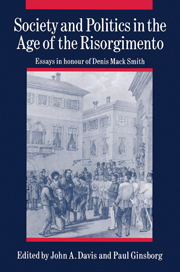Book contents
- Frontmatter
- Contents
- List of figures and maps
- List of contributors
- Preface
- Map 1 Italy in 1815
- Map 2 Italy in 1870
- Map 3 Italy – place names
- 1 1799: the Santafede and the crisis of the ancien régime in southern Italy
- 2 War and society in Napoleonic Italy: the armies of the Kingdom of Italy at home and abroad
- 3 The poor and how to relieve them: the Restoration debate on poverty in Italy and Europe
- 4 Bandits, violence and the organization of power in Sicily in the early nineteenth century
- 5 Marriage and the family in Italy in the early nineteenth century
- 6 After the Revolution: bandits on the plains of the Po 1848–54
- 7 Labouring women in northern and central Italy in the nineteenth century
- 8 Garibaldi in England: the politics of Italian enthusiasm
- 9 The middle classes in Liberal Italy
- 10 Francesco De Sanctis: the politics of a literary critic
- Bibliography of Denis Mack Smith's writings on nineteenth-century Italy
- Index
9 - The middle classes in Liberal Italy
Published online by Cambridge University Press: 30 January 2010
- Frontmatter
- Contents
- List of figures and maps
- List of contributors
- Preface
- Map 1 Italy in 1815
- Map 2 Italy in 1870
- Map 3 Italy – place names
- 1 1799: the Santafede and the crisis of the ancien régime in southern Italy
- 2 War and society in Napoleonic Italy: the armies of the Kingdom of Italy at home and abroad
- 3 The poor and how to relieve them: the Restoration debate on poverty in Italy and Europe
- 4 Bandits, violence and the organization of power in Sicily in the early nineteenth century
- 5 Marriage and the family in Italy in the early nineteenth century
- 6 After the Revolution: bandits on the plains of the Po 1848–54
- 7 Labouring women in northern and central Italy in the nineteenth century
- 8 Garibaldi in England: the politics of Italian enthusiasm
- 9 The middle classes in Liberal Italy
- 10 Francesco De Sanctis: the politics of a literary critic
- Bibliography of Denis Mack Smith's writings on nineteenth-century Italy
- Index
Summary
It seems by now generally agreed that the movement for national unification cannot be explained in terms of the immediate interests or needs of the Italian bourgeoisie. If there was a ‘bourgeois revolution’, it was not the bourgeoisie which made it. The industrial bourgeoisie was in its infancy, and from the standpoint of its restricted interests the creation of a national market was premature. Even in 1860 Italian industrialists were far from ready to exploit the opportunity offered to them. There was, indeed, no Italian industrial bourgeoisie in the strict sense of the term, only a number of regional groups. Industrialists were in the main concerned to protect their little enclaves from competition. The impulse for free trade had to come from outside. Long ago, in his classic work on the Risorgimento in Lombardy, Greenfield observed that even in the most advanced region of Italy it was the intellectuals and publicists, not the industrialists or merchants, who were in the forefront of the movement for economic modernization. I do not think that this should lead the historian to discard the usefulness of the notion of ‘bourgeois revolution’ when applied to the Risorgimento but rather to reformulate it in a less mechanical fashion. The sense in which the concept can be applied to the Risorgimento has been well defined by Luciano Cafagna: ‘the Risorgimento movement exists within the European age of the bourgeois revolution … Through the Risorgimento it is the bourgeoisie which grows, not other social classes… Through the transformations… it is the bourgeois mode of property and of the use of the labour force which affirms itself, not others’.
- Type
- Chapter
- Information
- Society and Politics in the Age of the RisorgimentoEssays in Honour of Denis Mack Smith, pp. 217 - 250Publisher: Cambridge University PressPrint publication year: 1991
- 2
- Cited by

